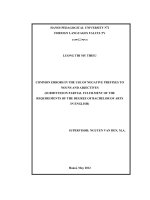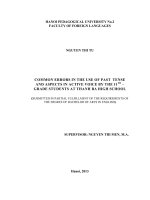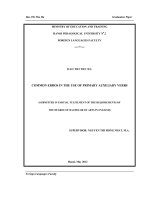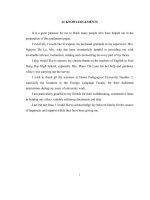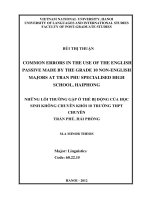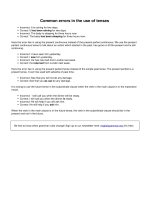Investigating common errors in the use of positions of english prepositions by non english major students at university of natural sciences m a 60 14 10
Bạn đang xem bản rút gọn của tài liệu. Xem và tải ngay bản đầy đủ của tài liệu tại đây (43.66 MB, 122 trang )
VIET NAM NATIONAL UNIVERSITY – HCM CITY
UNIVERSITY OF SOCIAL SCIENCES AND HUMANITIES
MASTER THESIS
INVESTIGATING COMMON ERRORS
IN THE USE OF ENGLISH PREPOSITIONS
BY NON-ENGLISH MAJOR STUDENTS
AT UNIVERSITY OF NATURAL SCIENCES
A thesis submitted in partial fulfillment of the requirements for the degree of
Master of Arts (TESOL)
Supervisor: ĐINH ĐIỀN, Assoc. Prof. - Ph. D.
Candidate: ÂU MINH TRIẾT – TESOL 2005
- 2010 -
CERTIFICATE OF ORIGINALITY
I hereby certify my authorship of the thesis submitted today entitled:
INVESTIGATING COMMON ERRORS
IN THE USE OF ENGLISH PREPOSITIONS
BY NON-ENGLISH MAJOR STUDENTS
AT UNIVERSITY OF NATURAL SCIENCES
In terms of the Statement of
Requirements for Theses in Master’s Programs
Issued by the Higher Degree Committee
Ho Chi Minh City, March 2010
ÂU MINH TRIẾT
RETENTION AND USE OF THE THESIS
i
I, hereby state that I, AÂu Minh Triết, being the candidate for the degree of
Master of TESOL, accept the requirements of the University relating to the retention
and use of Master’s Thesis deposited in the library.
In terms of these conditions, I agree that the original of my thesis deposited in
the library should be accessible for the purposes of study and research, in
accordance with the normal conditions established by the library for the care, loan or
reproduction of the thesis.
Ho Chi Minh City, March 2010
ÂU MINH TRIẾT
ii
ACKNOWLEDGEMENTS
I would like to express my deepest gratitude to my thesis supervisor,
Associate Professor, Doctor Ñinh Ñiền, for his explicit guidance and valuable
support to the completion of my thesis. Without his whole-hearted guidance, I could
not have finished the thesis.
I am also grateful to all my teachers, especially Doctor Nguyễn Kiều Thu
and Doctor Nguyễn Hoàng Tuấn, for valuable and helpful instructions during the
three-year TESOL course (2005-2008).
I should also like to express my special thanks to the library staff of the
University of Social Sciences and Humanities who help me with my search for
reference materials.
I also would like to sincerely thank Mr. Phan Văn Báo, the Headmaster of
Ha Tien High School. I have been offered wonderful conditions to fulfill my
learning from him, without his support, I would be unable to fulfill my learning.
In addition, I am indebted to all my colleagues and classmates, especially
Mr. Võ Duy Minh, the class monitor, who give me valuable advice and assistance
in developing the study.
Thanks also to my students for their cooperation in giving truly response to
the questionnaire.
Finally, my special thanks to my family for their unfailing support.
iii
TABLE OF CONTENTS
Page
Certificate of originality ....................................................................................... i
Retention and use of the thesis.............................................................................. ii
Acknowledgements ............................................................................................. iii
Table of contents .................................................................................................. . iv
List of figures ....................................................................................................... ix
List of tables ........................................................................................................ x
List of abbreviations ............................................................................................ xi
Abstract ................................................................................................................ xii
CHAPTER 1: INTRODUCTION ..................................................................... 1
1.1 BACKGROUND TO THE STUDY ............................................................ 2
1.2 STATEMENT OF THE PURPOSE ............................................................ 4
1.3 RESEARCH QUESTIONS ......................................................................... 6
1.4 SIGNIFICANCE OF THE STUDY ............................................................. 7
1.5 SCOPE OF THE STUDY ........................................................................... 8
1.6 LIMITATIONS OF THE STUDY .............................................................. 9
1.7 STRUCTURE OF THE THESIS ................................................................ 10
CHAPTER 2: LITERATURE REVIEW ........................................................ 11
2.1 ERRORS VERSUS MISTAKES IN LEARNING SECOND LANGUAGE 11
2.2 ENGLISH PREPOSITIONS ....................................................................... 12
2.2.1 CLASSES OF ENGLISH PREPOSITIONS ....................................... 13
2.2.1.1 SPATIAL PREPOSITIONS ........................................................ 13
2.2.1.2 TEMPORAL PREPOSITIONS ................................................... 14
2.2.1.3 LOGICAL PREPOSITIONS ....................................................... 15
2.2.2 ERRORS IN THE USE OF ENLISH PREPOSITIONS ...................... 15
2.3 CORPUS LINGUISTICS ............................................................................ 18
2.3.1 BROWN CORPUS ............................................................................ 21
iv
2.3.2 PAUL NATION’S 1000 MOST FREQUENT WORD FAMILIES ..... 22
2.4 BRITISH NATIONAL CORPUS ............................................................... 23
2.4.1 AN OVERVIEW OF BRITISH NATIONAL CORPUS ..................... 23
2.4.2 HOW TO USE BRITISH NATIONAL CORPUS .............................. 24
2.5 SUMMARY ............................................................................................... 27
CHAPTER 3: RESEARCH METHODOLOGY ............................................. 28
3.1 RESEARCH DESIGN ................................................................................ 28
3.2 SUBJECTS ................................................................................................. 29
3.3 RESEARCH PROCEDURES ..................................................................... 29
3.4 INSTRUMENTS AND MATERIALS ........................................................ 31
3.4.1 INSTRUMENTS ................................................................................ 31
3.4.1.1 QUESTIONNAIRE ..................................................................... 32
3.4.1.2 TEST GENERATOR SOFTWARE OF EXAMVIEW 6.2 .......... 33
3.4.1.3 SOFTWARE OF CONCORDANCE VERSION 3.2 ................... 33
3.4.1.4 MICROSOFT OFFICE EXCEL .................................................. 34
3.4.1.5 PERCENTAGE ........................................................................... 35
3.4.2 MATERIALS ..................................................................................... 35
3.4.2.1 QUESTIONS ON PREPOSITIONS ............................................ 36
3.4.2.1.1 FOR THE TESTS ................................................................ 36
3.4.2.1.1.1 CONSTRUCTING THE TEST QUESTIONS ............... 36
3.4.2.1.1.2 CONSTRUCTING THE DIFFICULTY LEVEL TO THE
WORDS USED IN THE QUESTIONS .......................... 38
3.4.2.1.1.3 ADMINISTERING THE TEST .................................... 39
3.4.2.1.2 FOR THE FINAL EXAM .................................................... 40
3.4.2.2 COURSE BOOK ......................................................................... 40
3.5 SUMMARY ............................................................................................... 40
CHAPTER 4 : FINDINGS AND DISCUSSION .............................................. 41
4.1 DATA ANALYSIS ..................................................................................... 41
v
4.1.1 DETAILED ANALYSIS OF THE QUESTIONNAIRE ..................... 41
4.1.1.1 STUDENTS’ PERSONAL INFORMATION .............................. 42
4.1.1.1.1 STUDENTS’ GENDERS ..................................................... 42
4.1.1.1.2 STUDENTS’ PRIVATE TUTORS ...................................... 43
4.1.1.1.3 STUDENTS’ SELF-ASSESSMENT .................................... 44
4.1.1.2 STUDENTS’ POINTS OF VIEW ............................................... 45
4.1.1.2.1 QUESTION 1 ...................................................................... 45
4.1.1.2.2 QUESTION 2 ...................................................................... 46
4.1.1.2.3 QUESTION 3 ...................................................................... 47
4.1.1.2.4 QUESTION 4 ...................................................................... 48
4.1.1.2.5 QUESTION 5 ...................................................................... 49
4.1.1.2.6 QUESTION 6 ...................................................................... 50
4.1.2 DETAILED ANALYSIS OF THE TESTS AND EXAM PAPERS .... 50
4.1.2.1 RESULTS BASED ON THE PREPOSITIONS .......................... 51
4.1.2.1.1 PREPOSITION AT .............................................................. 51
4.1.2.1.2 PREPOSITION BEHIND .................................................... 51
4.1.2.1.3 PREPOSITION BY .............................................................. 52
4.1.2.1.4 PREPOSITION FOR ........................................................... 53
4.1.2.1.5 PREPOSITION IN ............................................................... 53
4.1.2.1.6 PREPOSITION INTO .......................................................... 54
4.1.2.1.7 PREPOSITION ON ............................................................. 55
4.1.2.1.8 PREPOSITION OVER ........................................................ 55
4.1.2.1.9 PREPOSITION THROUGH ................................................ 56
4.1.2.1.10 PREPOSITION TO ............................................................ 57
4.1.2.2 RESULTS BASED ON THE SPATIAL, TEMPORAL AND
LOGICAL MEANINGS ............................................................. 57
4.2 FINDINGS ................................................................................................. 59
4.2.1 WITH THE QUESTIONS ABOUT PERSONAL INFORMATION ... 59
4.2.2 WITH THE QUESTIONS ABOUT STUDENTS’ ATTITUDES ........ 59
4.2.2.1 STUDENTS’ POINTS OF VIEW TOWARDS THE USE OF
BNC ..................................................................................... 60
vi
C.33.44.55.54.78.65.5.43.22.2.4..22.Tai lieu. Luan 66.55.77.99. van. Luan an.77.99.44.45.67.22.55.77.C.37.99.44.45.67.22.55.77.C.37.99.44.45.67.22.55.77.C.37.99.44.45.67.22.55.77.C.33.44.55.54.78.655.43.22.2.4.55.22. Do an.Tai lieu. Luan van. Luan an. Do an.Tai lieu. Luan van. Luan an. Do an
4.2.2.2 STUDENTS’ POINTS OF VIEW TOWARDS THE USE OF
ENGLISH PREPOSITIONS .................................................................... 60
4.2.3 WITH THE PREPOSITIONS ............................................................ 61
4.2.4 WITH SPATIAL, TEMPORAL AND LOGICAL MEANINGS OF THE
PREPOSITIONS ................................................................................ 64
4.3 DISCUSSION ............................................................................................. 64
4.3.1 RELIABILITY OF THE DIFFICULTY LEVEL OF WORDS USED
IN THE QUESTIONS FOR TESTS .................................... 64
4.3.2 RESPONSE TO THE RESEARCH QUESTIONS ............................. 68
4.4 SUMMARY ............................................................................................... 72
CHAPTER 5: CONCLUSION, IMPLICATIONS & RECOMMENDATIONS . 73
5.1 IMPLICATIONS ........................................................................................ 73
5.2 RECOMMENDATIONS ............................................................................ 74
5.3 CONCLUSION .......................................................................................... 75
BIBLIOGRAPHY ............................................................................................. 77
ONLINE BIBLIOGRAPHY ............................................................................. 81
APPENDIX A .................................................................................................... 83
APPENDIX B .................................................................................................... 88
APPENDIX C .................................................................................................... 92
vii
@edu.gmail.com.vn.bkc19134.hmu.edu.vn
C.33.44.55.54.78.65.5.43.22.2.4..22.Tai lieu. Luan 66.55.77.99. van. Luan an.77.99.44.45.67.22.55.77.C.37.99.44.45.67.22.55.77.C.37.99.44.45.67.22.55.77.C.37.99.44.45.67.22.55.77.C.33.44.55.54.78.655.43.22.2.4.55.22. Do an.Tai lieu. Luan van. Luan an. Do an.Tai lieu. Luan van. Luan an. Do an
viii
@edu.gmail.com.vn.bkc19134.hmu.edu.vn
C.33.44.55.54.78.65.5.43.22.2.4..22.Tai lieu. Luan 66.55.77.99. van. Luan an.77.99.44.45.67.22.55.77.C.37.99.44.45.67.22.55.77.C.37.99.44.45.67.22.55.77.C.37.99.44.45.67.22.55.77.C.33.44.55.54.78.655.43.22.2.4.55.22. Do an.Tai lieu. Luan van. Luan an. Do an.Tai lieu. Luan van. Luan an. Do an
LIST OF FIGURES
Figure 1: The interface of British National Corpus .............................................. 25
Figure
2:
The
results
of
searching
for
the
phrase
“on
the
river”
…………………………. 26
Figure 3: The results of searching for the phrase “under the river” ...................... 26
Figure 4: The number of students in the distributions of genders ......................... 42
Figure 5: The distribution of the students’ periods in learning English ................ 43
Figure 6: Students’ self-assessment for their English level .................................. 45
Figure 7: Students’ points of view towards using British National Corpus in learning
English prepositions .......................................................................... 46
Figure 8: Students’ behavior for reading British National Corpus’ examples ...... 48
Figure 9: Students’ attitudes towards the roles of prepositions in contexts .......... 48
Figure 10: Difficulties causing students to use prepositions incorrectly .............. 49
Figure 11: Improvement after using British National Corpus .............................. 50
Figure 12: The common aspect in making errors for prepositions tests of students in
the research in the academic year of 2007-2008 and 2008-2009. 71
ix
@edu.gmail.com.vn.bkc19134.hmu.edu.vn
C.33.44.55.54.78.65.5.43.22.2.4..22.Tai lieu. Luan 66.55.77.99. van. Luan an.77.99.44.45.67.22.55.77.C.37.99.44.45.67.22.55.77.C.37.99.44.45.67.22.55.77.C.37.99.44.45.67.22.55.77.C.33.44.55.54.78.655.43.22.2.4.55.22. Do an.Tai lieu. Luan van. Luan an. Do an.Tai lieu. Luan van. Luan an. Do an
LIST OF TABLES
Table 1: Results from the preposition questions with preposition “at” ................ 51
Table 2: Results from the preposition questions with preposition “behind” ......... 52
Table 3: Results from the preposition questions with preposition “by” ................ 52
Table 4: Results from the preposition questions with preposition “for” ............... 53
Table 5: Results from the preposition questions with preposition “in” ................ 54
Table 6: Results from the preposition questions with preposition “into” ............. 54
Table 7: Results from the preposition questions with preposition “on” ............... 55
Table 8: Results from the preposition questions with preposition “over” ............ 56
Table 9: Results from the preposition questions with preposition “through” ...... 56
Table 10: Results from the preposition questions with preposition “to” .............. 57
Table 11: Results in three tests of the two academic years in percentage in terms of
spatial, temporal and logical meanings ............................................... 58
Table 12: Correct answers and errors that students in the research made in the tests
and exam in percent ........................................................................... 61
Table 13: Correct answers and errors that students in the research made in the six
tests in percent in the academic year of 2007-2008 and 2008-2009. 63
Table 14: Comparison for the difficulty level of words among spatial meanings,
temporal meanings and logical meanings of the prepositions ............. 65
Table 15: The order of errors made with the ten prepositions in question ............ 69
Table 16: Comparison for the order in Brown Corpus and error percents ........... 69
x
@edu.gmail.com.vn.bkc19134.hmu.edu.vn
C.33.44.55.54.78.65.5.43.22.2.4..22.Tai lieu. Luan 66.55.77.99. van. Luan an.77.99.44.45.67.22.55.77.C.37.99.44.45.67.22.55.77.C.37.99.44.45.67.22.55.77.C.37.99.44.45.67.22.55.77.C.33.44.55.54.78.655.43.22.2.4.55.22. Do an.Tai lieu. Luan van. Luan an. Do an.Tai lieu. Luan van. Luan an. Do an
LIST OF ABBREVIATIONS
1st group
: First group
2nd group
: Second group
BNC
: British National Corpus
UNS
: University of Natural Sciences
xi
@edu.gmail.com.vn.bkc19134.hmu.edu.vn
C.33.44.55.54.78.65.5.43.22.2.4..22.Tai lieu. Luan 66.55.77.99. van. Luan an.77.99.44.45.67.22.55.77.C.37.99.44.45.67.22.55.77.C.37.99.44.45.67.22.55.77.C.37.99.44.45.67.22.55.77.C.33.44.55.54.78.655.43.22.2.4.55.22. Do an.Tai lieu. Luan van. Luan an. Do an.Tai lieu. Luan van. Luan an. Do an
ABSTRACT
This thesis aims at investigating the common errors in the use of the ten
most frequent English prepositions by non-majored English students at the
University of Natural Sciences (UNS). The ten most frequent English prepositions
studied by the research were at, behind, by, for, in, into, on, over, through and to.
To get this purpose, the research was carried out by means of a
questionnaire, three tests on prepositions, and an exam paper in English. The
research was done with 104 non-majored English students at the UNS in their first
terms of the two academic years of 2007-2008, including 55 students called first
group (1 st group) and 2008-2009, including 49 students called second group (2nd
group). The students in the research were not taught the rule guiding the use of
English prepositions. They were instructed to use British National Corpus (BNC) to
learn how to use English prepositions instead.
Their responses to the questionnaire were used to analyze their attitudes
towards English prepositions and BNC; whereas their results of the three tests and
exam paper were used to consider their common errors in the use of English
prepositions in term of the preposition itself and in terms of the spatial, temporal
and logical meanings of prepositions.
The findings proved that in terms of prepositions themselves, the students at
the UNS made most errors with the proposition behind and least with the
preposition into. Between these two prepositions were in turn downward through,
by, over, in, to, on, for, and at. In terms of the spatial, temporal and logical
meanings of prepositions, the results also showed that the logical meaning of each
preposition in the research caused them the most errors and the temporal meaning
had the least ones. Based on these findings, some recommendations were made to
improve the further study.
Implications from the research results focused on suggesting some
pedagogical issues of teaching English prepositions:
xii
@edu.gmail.com.vn.bkc19134.hmu.edu.vn
C.33.44.55.54.78.65.5.43.22.2.4..22.Tai lieu. Luan 66.55.77.99. van. Luan an.77.99.44.45.67.22.55.77.C.37.99.44.45.67.22.55.77.C.37.99.44.45.67.22.55.77.C.37.99.44.45.67.22.55.77.C.33.44.55.54.78.655.43.22.2.4.55.22. Do an.Tai lieu. Luan van. Luan an. Do an.Tai lieu. Luan van. Luan an. Do an
Among the three aspects of the prepositions’ meanings spatial, temporal, and logical - the logical meaning of the
preposition should be paid more attention to.
Corpora should be applied to teaching English as a second or a
foreign language.
xiii
@edu.gmail.com.vn.bkc19134.hmu.edu.vn
C.33.44.55.54.78.65.5.43.22.2.4..22.Tai lieu. Luan 66.55.77.99. van. Luan an.77.99.44.45.67.22.55.77.C.37.99.44.45.67.22.55.77.C.37.99.44.45.67.22.55.77.C.37.99.44.45.67.22.55.77.C.33.44.55.54.78.655.43.22.2.4.55.22. Do an.Tai lieu. Luan van. Luan an. Do an.Tai lieu. Luan van. Luan an. Do an
CHAPTER 1
INTRODUCTION
Prepositions according to Lawal (2004, in Onike, 2007, Introduction section:
¶1) indicate various relationships between words or phrases in sentences. The
relationship includes those of time, points, position, direction and various degrees of
mental or emotional attitudes. Prepositions like other parts of speech are frequently
misused by the learners of the English language, especially under the second language
learning situation. This misuse is referred to as an error.
In addition, Onike (2007, Introduction section: ¶2) found that one major error
observed in the students writing and everyday speech is the prepositional error. Many
students used the prepositions carelessly as if they are not rule-governed. This happens
because the rule guiding the use of prepositions is somehow flexible. Adewuyi (2001,
in Onike, 2007, Introduction section: ¶3) also contributes that the misuse of
prepositions is mainly caused by linguistic interference factors, inappropriate learning
and wrong application of rules.
This study aims firstly to identify the common errors in the use of the ten
English prepositions of at, behind, by, for, in, into, on, over, through, and to, and
secondly to find out which meanings of the ten mentioned prepositions causing
problems to students at the UNS. It suggests an effective way of helping students to
improve themselves in the use of the ten English prepositions in question, particularly,
and of English prepositions, generally.
This chapter presents (1) background to the study, (2) statement of the purpose,
(3) research questions, (4) significance of the study, (5) scope of the study, (6)
limitations of the study, and (7) structure of the thesis.
1.1 BACKGROUND TO THE STUDY
Prepositions are often among the most frequent words in a language. Based on
the British National Corpus (Burnard, 2000), four out of the top-ten most-frequent
1
@edu.gmail.com.vn.bkc19134.hmu.edu.vn
C.33.44.55.54.78.65.5.43.22.2.4..22.Tai lieu. Luan 66.55.77.99. van. Luan an.77.99.44.45.67.22.55.77.C.37.99.44.45.67.22.55.77.C.37.99.44.45.67.22.55.77.C.37.99.44.45.67.22.55.77.C.33.44.55.54.78.655.43.22.2.4.55.22. Do an.Tai lieu. Luan van. Luan an. Do an.Tai lieu. Luan van. Luan an. Do an
words in English are the four prepositions: of, to, in, and for (Baldwin, Kordoni &
Villavicencio, 2009, Introduction section, ¶3). For all second language learners, the
English prepositions always cause problems. Brala (2002: 1) found the following:
Most, if not all, (E)FL teachers and students are painfully aware of the
fact that when it comes to mastering a foreign language one of the most
troublesome areas to learn is the (idiomatic) usage of prepositions.
And in his study, Onike (2007: Chapter three section, ¶2) showed that “The
study by Azeez (2005) reveals that the misuse of prepositions is one of the observable
errors in the students’ use of English in the school”. In addition, after many years of
teaching English at McGill University for students from all over the world, Prieur and
Speyer (1988: 77) confessed that:
In my work with students from many parts of the world at the Center for
the Development of Writing, at the Faculty of Education, McGill
University, I had difficulty explaining why one preposition was used
and not another – the reason being that there is rarely a “why”.
In fact, many Vietnamese learners thought that using English prepositions
appropriately is utopian. For the majority of students, learning English prepositions is
both very difficult and time-consuming. Regardless of mountains of books,
enormousness of preposition tests and lessons, English prepositions are still the
challenges for Vietnamese students; and regardless of the similarity between
Vietnamese and English in the pre-position structure – that is the noun will follow
almost directly the preposition, such as “on the river” can be translated word for word
into Vietnamese as “trên sông”, Vietnamese students, especially who are nonmajored English, still discover that English prepositions are troublesome.
The problems can be seen as:
The preposition itself is rather meaningless and hard to be defined.
Kreidler (1966: 121) pointed out, “Meaning is not a reliable guide to the
choice of prepositions”. It should be noted that speakers, even native
2
@edu.gmail.com.vn.bkc19134.hmu.edu.vn
C.33.44.55.54.78.65.5.43.22.2.4..22.Tai lieu. Luan 66.55.77.99. van. Luan an.77.99.44.45.67.22.55.77.C.37.99.44.45.67.22.55.77.C.37.99.44.45.67.22.55.77.C.37.99.44.45.67.22.55.77.C.33.44.55.54.78.655.43.22.2.4.55.22. Do an.Tai lieu. Luan van. Luan an. Do an.Tai lieu. Luan van. Luan an. Do an
speakers, when uttering a preposition they usually use their hands to
support the idea and to show how something is situated in relationship to
something else. In addition, Pittman (1966: 15) stated that “Prepositions
have
earned a
reputation for
difficulty if not a
downright
unpredictability”. Furthermore, Turewicz (2005: 1) stated that:
Among reasons responsible for this state of affairs I would
enumerate the fact that, as the findings about prepositions
published within the Collins COBUILD series (1991-1997) show,
ten prepositions: at, by, for, from, in+into, of, on, to and with
realize more than two hundred meanings.
And Swan (1997:436) affirmed that the preposition at can be
listed with eighteen main uses.
Prepositions almost come out at the weak forms, and are unstressed
words in the utterances. A listener, either a second language user or a
native speaker, almost pays attention to the key words in the utterances those are verbs, nouns or pronouns, but ignores the prepositions. Even
when the listener cannot hear the prepositions in the utterances he or she
can guess them out. Otherwise, the listener will easily fail to do with
verbs, nouns or adjectives. Cienki (1984:4) noted that “People seem
never to have taken prepositions seriously”.
The differences in the way of perceiving the world between Vietnamese
and Western people also makes problems to Vietnamese students in the
use of English prepositions. According to Lý Toàn Thắng (2005),
Vietnamese people consider words from the position of the observer
whereas English people consider words under the position of the object.
For example, while Westerners say “The boat is on the river”, hardly do
Vietnamese people say “Thuyền chạy trên sông” even though the
boat is really on the river. They say “Thuyền chạy dưới sông”
3
@edu.gmail.com.vn.bkc19134.hmu.edu.vn
C.33.44.55.54.78.65.5.43.22.2.4..22.Tai lieu. Luan 66.55.77.99. van. Luan an.77.99.44.45.67.22.55.77.C.37.99.44.45.67.22.55.77.C.37.99.44.45.67.22.55.77.C.37.99.44.45.67.22.55.77.C.33.44.55.54.78.655.43.22.2.4.55.22. Do an.Tai lieu. Luan van. Luan an. Do an.Tai lieu. Luan van. Luan an. Do an
instead, because the boat, from the position of the observer – that is on a
bank is actually in a lower position.
In fact, the difference between English and good English is usually the right
prepositions. And Zughoul (1979:24) stated that “Prepositions are an everlasting
problem for foreign learners of English”. Therefore, the research was carried out to
help students partly solve the problems on the use of English prepositions.
1.2 STATEMENT OF THE PURPOSE
English prepositions are generally considered difficult to teach to non-native
speakers because of a variety of reasons.
Firstly, a large number of possible meanings for many prepositions change due
to the context in which they are used.
Secondly, there is interference from the commonly-used grammar-translation
method of instruction and native language for native Vietnamese learners. This
teaching method have formed in students – especially English non-major ones – the
habit of using English by translating rather than by imitating native speakers’ ways of
using English. In term of using English prepositions, this teaching method makes
students translate the Vietnamese prepositions in the sentence into the relevant English
prepositions. This results in the students' loss of fluency as they are usually trying to
analyze rules and grammar before actually saying anything, in order to avoid being
"punished" for being wrong.
According to Zughoul (1979, abstract section:¶1), there are some potentially
more effective approaches to teaching prepositions, including Kreidler's association
approach, Hornby's unit method, Langendoen's role-subdivisions, Close's relationships
approach, Pittman's demonstrable uses, and Lindstromberg’s system of icons. In most
of the above approaches, there has been a stress on teaching isolated structures, even
situationalized, and little emphasis on real communication. The common for these
teaching methods is to base on students’ consciousness. That is to say, students have to
4
@edu.gmail.com.vn.bkc19134.hmu.edu.vn
C.33.44.55.54.78.65.5.43.22.2.4..22.Tai lieu. Luan 66.55.77.99. van. Luan an.77.99.44.45.67.22.55.77.C.37.99.44.45.67.22.55.77.C.37.99.44.45.67.22.55.77.C.37.99.44.45.67.22.55.77.C.33.44.55.54.78.655.43.22.2.4.55.22. Do an.Tai lieu. Luan van. Luan an. Do an.Tai lieu. Luan van. Luan an. Do an
think about the case that the prepositions should be used first, and then they make the
sentences.
The results have some limits. Zughoul pointed out that if communication is a
primary goal of English teaching and learners come to English prepositions as the
users other than the “would be linguists”, they should acquire the English prepositions
sub-consciously rather than learn those consciously with rules follow rules, exceptions
follow exceptions (Zughoul, 1979, abstract section:¶1).
In years of teaching students how to use English prepositions at the UNS, the
author of the thesis found that the traditional way had some limits. Students often
complained that they were unable to remember all rules and exceptions of the use of
English prepositions. It also took them a great deal of time to finish their exam papers.
Additionally, the results that the thesis author got from students were not satisfactory.
Averagely, only 30% of the preposition questions were responded correctly.
Upon on the writer’s observations, errors in the use of English prepositions that
non-majored English learners at the UNS have often made can be seen as resulting in:
Prepositions are almost meaningless and undefined;
Prepositions are not the key words and unclear in utterances;
And the way of perceiving the relationship between the prepositions and
the followed nouns of Vietnamese people differs from that of English
people.
To sum up, this study aims to find out the students’ common errors in the use of
English prepositions in terms of the preposition itself and in terms of the spatial
meaning, temporal meaning and logical meaning of the prepositions. The research also
investigated the effectiveness of using BNC to learn English prepositions on students
at the UNS.
1.3 RESEARCH QUESTIONS
The research aims to answer the following three research questions:
5
@edu.gmail.com.vn.bkc19134.hmu.edu.vn
C.33.44.55.54.78.65.5.43.22.2.4..22.Tai lieu. Luan 66.55.77.99. van. Luan an.77.99.44.45.67.22.55.77.C.37.99.44.45.67.22.55.77.C.37.99.44.45.67.22.55.77.C.37.99.44.45.67.22.55.77.C.33.44.55.54.78.655.43.22.2.4.55.22. Do an.Tai lieu. Luan van. Luan an. Do an.Tai lieu. Luan van. Luan an. Do an
1. What are common errors made by the student subjects in dealing with
English prepositions?
2. What are common errors made by the student subjects in dealing with the
spatial, temporal and logical meanings of the ten English prepositions in
question?
3. How do the student subjects improve their use of the ten English
prepositions in question after applying British National Corpus?
1.4 SIGNIFICANCE OF THE STUDY
On the one hand, mastering English prepositions is very important. As
mentioned previously, the difference between English and good English is usually the
right prepositions. However, Lindstromberg (2001 in Baldwin, Kordoni &
Villavicencio, 2009: Introduction section, ¶4) estimates that only less than 10% of
upper-level English as a Second Language (ESL) students can use and understand
prepositions correctly. Other researchers have also come up with a similar conclusion
which will be discussed in details in the next chapter. On the other hand, a
considerable number of students would like to master a foreign language and see
independent learning as a goal. Their success, however, seems quite limited because
they lack basic knowledge on the langue and an effective study method.
The author of the thesis has a strong belief that applying BNC to learning
English prepositions helps students be able to use prepositions more effectively.
This study is, therefore, carried out in the hope of helping students at the UNS
find out their common errors in the use of English prepositions as well as supply them
a new effective study method. Findings from this study will be the base for suggestions
to innovate the situation.
1.5 SCOPE OF THE STUDY
6
@edu.gmail.com.vn.bkc19134.hmu.edu.vn
C.33.44.55.54.78.65.5.43.22.2.4..22.Tai lieu. Luan 66.55.77.99. van. Luan an.77.99.44.45.67.22.55.77.C.37.99.44.45.67.22.55.77.C.37.99.44.45.67.22.55.77.C.37.99.44.45.67.22.55.77.C.33.44.55.54.78.655.43.22.2.4.55.22. Do an.Tai lieu. Luan van. Luan an. Do an.Tai lieu. Luan van. Luan an. Do an
The study was done with non-majored English students at the UNS. The
English level of those students was not much fluent. Some of them even found it
difficult to express simple ideas in daily conversations. Thus, the study was delimitated
with this English level.
Among over 50 English prepositions, the study has been delimitated with only
10 common prepositions. They are at, behind, by, for, in, into, on, over, through and
to. Those prepositions were taken into the study because they were used very
frequently in English. According to Brown Corpus 5000 most frequent words, those
prepositions take the order of being used frequently as follows:
No
Preposition
1
2
3
4
5
6
7
8
9
10
to
in
for
on
at
by
into
over
through
behind
Order in list of 5000 MFW
of Brown Corpus
4
6
11
16
18
19
58
80
92
362
Frequency of being
used in %
2.5744
2.1010
0.9340
0.6636
0.5293
0.5224
0.1763
0.1218
0.0954
0.0254
Other prepositions also being used frequently, such as of, with, from, about,
like, since, against, without, until, etc. have not been taken into the study because these
prepositions do not cover all three aspects of spatial, temporal and logical meanings.
The following table displays different prepositions which have the order in the
list of 5000 MFW of Brown Corpus over the preposition of behind (at the place of 362
on the order list) but were not taken into the study.
o
Preposition
Order in list of 5000 MFW of
Brown Corpus
1
2
3
4
5
of
with
from
about
after
2
13
26
57
86
N
7
@edu.gmail.com.vn.bkc19134.hmu.edu.vn
Frequency of being
used
%
3.5839
0.7176
0.4301
0.1787
0.1053
C.33.44.55.54.78.65.5.43.22.2.4..22.Tai lieu. Luan 66.55.77.99. van. Luan an.77.99.44.45.67.22.55.77.C.37.99.44.45.67.22.55.77.C.37.99.44.45.67.22.55.77.C.37.99.44.45.67.22.55.77.C.33.44.55.54.78.655.43.22.2.4.55.22. Do an.Tai lieu. Luan van. Luan an. Do an.Tai lieu. Luan van. Luan an. Do an
6
7
8
9
10
11
12
13
before
through
down
between
under
off
around
upon
90
92
100
126
129
141
161
174
0.1000
0.0954
0.0881
0.0719
0.0696
0.0630
0.0552
0.0487
1.6 LIMITATIONS OF THE STUDY
There are some limitations in the study:
Firstly, this study confines itself to investigating a considerable number of
students at the UNS and giving recommendations are to the students majoring in
Information Technology at this academic setting. The result of the thesis may not be
properly applied to the students of other majors at the UNS as well as the students of
other universities.
Secondly, this is due to the fact that corpus is a multifactor concept; the author
of the thesis cannot help resorting from various sources to have a sufficient literature
review.
In spite of the above-mentioned limitations of the thesis, its author hopes that
this study does make a small contribution to the innovation of students’ situation at the
UNS.
1.7 STRUCTURE OF THE THESIS
The thesis is presented in five chapters.
Chapter 1 provides (1) the background to the study, (2) the statement of the
purpose, (3) the three research questions, (4) the significance of the study, (5) the
scope of the study, (6) limitations of the study, and (7) the structure of the thesis.
Chapter 2 reviews the relevant literature and research to the study consisting of
(1) the classes of English prepositions and the errors in the use of them, (2) the
introduction to Corpus Linguistics, including Brown Corpus and Paul Nation’s 100
8
@edu.gmail.com.vn.bkc19134.hmu.edu.vn
C.33.44.55.54.78.65.5.43.22.2.4..22.Tai lieu. Luan 66.55.77.99. van. Luan an.77.99.44.45.67.22.55.77.C.37.99.44.45.67.22.55.77.C.37.99.44.45.67.22.55.77.C.37.99.44.45.67.22.55.77.C.33.44.55.54.78.655.43.22.2.4.55.22. Do an.Tai lieu. Luan van. Luan an. Do an.Tai lieu. Luan van. Luan an. Do an
most frequent word families, and (3) the overview of British National Corpus as well
as how to use it.
Chapter 3 presents the methodology employed in the research done at the
UNS. The data collected for the research are from a set of questionnaire, three tests on
prepositions as well as an exam paper.
Chapter 4 discusses the findings of this M.A. thesis and analyzes questionnaire
responses as well as the percentage of tests and exam paper in the light of the research
literature review.
Chapter 5 summarizes the findings of the study and raises a number of
suggestions in the hope of contributing something to the improvement of students’
situation.
9
@edu.gmail.com.vn.bkc19134.hmu.edu.vn
C.33.44.55.54.78.65.5.43.22.2.4..22.Tai lieu. Luan 66.55.77.99. van. Luan an.77.99.44.45.67.22.55.77.C.37.99.44.45.67.22.55.77.C.37.99.44.45.67.22.55.77.C.37.99.44.45.67.22.55.77.C.33.44.55.54.78.655.43.22.2.4.55.22. Do an.Tai lieu. Luan van. Luan an. Do an.Tai lieu. Luan van. Luan an. Do an
CHAPTER 2
LITERATURE REVIEW
This chapter presents relevant theories and studies essential for the issues
discussed in the thesis. The chapter consists of 5 sections: (1) errors versus mistakes in
learning second language, (2) English prepositions, (3) Corpus Linguistics, (4) British
National Corpus, and (5) summary.
2.1 ERRORS VERSUS MISTAKES IN LEARNING SECOND LANGUAGE
In order to distinguish errors and mistakes in learning second language, Corder
(1967, 1971) and James (1998) used the aspect of self-correctability to make the
distinction. According to these authors, a mistake can be more or less self-corrected
while an error cannot be recognizable by learners. Brown (1980:165; 1994:205) also
came to the same conclusion, stating that “a performance error that is either a random
guess or a slip in that it is a failure to utilize a known system correctly” whereas “an
error is a noticeable deviation from the adult grammar of a native speaker, reflecting
the inter-language competence of a learner.” Similarly, Richards et al. (1992:127)
defined that errors result from incomplete knowledge and mistakes are caused by lack
of attention, fatigue, carelessness or some aspects of performance. In short, "mistakes
are akin to slips of the tongue. That is, they are generally one-time-only events. The
speaker who makes a mistake is able to recognize it as a mistake and correct it if
necessary. An error, on the other hand, is systematic. That is, it is likely to occur
repeatedly and is not recognized by the learner as an error" (Susan M. and Larry
Selinker; 2001:67).
Errors then relate to the use of linguistic items as words, grammatical items in a
way which a fluent or native speaker of the language regards as showing faulty or
incomplete language. Lennon (1991) considered an error “is a linguistic form or
combination of forms which in the same context and under similar conditions of
10
@edu.gmail.com.vn.bkc19134.hmu.edu.vn
C.33.44.55.54.78.65.5.43.22.2.4..22.Tai lieu. Luan 66.55.77.99. van. Luan an.77.99.44.45.67.22.55.77.C.37.99.44.45.67.22.55.77.C.37.99.44.45.67.22.55.77.C.37.99.44.45.67.22.55.77.C.33.44.55.54.78.655.43.22.2.4.55.22. Do an.Tai lieu. Luan van. Luan an. Do an.Tai lieu. Luan van. Luan an. Do an
production would, in all likelihood, not be produced by the speakers' native speaker
counterparts.” According to the Contrastive Analysis Hypothesis, errors occur as a
result of interference when the learners transfer native language habits into the L2. It
was also believed that interference takes place whenever there is a difference between
native mother tongue and the target language. The hypothesis based on Lado's
suggestion in linguistic across cultures where he states "in the comparison between
native and foreign language lies the key to ease all difficulties in foreign language
learning" (Lado, 1957).
In this study, students learned using English prepositions without learning the
rules of using English prepositions. These students, then, use the ten English
prepositions in questions in such a way that they transfer native language habits into
English. The word “errors” in this study is used under this aspect.
2.2 ENGLISH PREPOSITIONS
Prepositions are a class of words that indicate relationships between nouns,
pronouns and other words in a sentence. They often come before a noun. They never
change their forms, regardless of the cases, genders, etc. of the words they are referring
to. According to Lawal (2004, in Onike, 2007: Introduction section, ¶1), prepositions
indicate various relationships between words or phrases in sentences. The relationship
includes those of time, points, position, direction and various degrees of mental or
emotional attitudes. In addition, Agoi (2003, in Onike, 2007: Introduction section, ¶1)
also described the preposition as a word or group of words used with a noun or noun
equivalents to show the link between that noun which it governs and another word.
Throughout the history of the English language, some new prepositions have come
into use while others have fallen out of use as well as the meaning of some existing
prepositions have been changed. However, among those prepositions, there are only
around fifty prepositions used commonly.
11
@edu.gmail.com.vn.bkc19134.hmu.edu.vn
